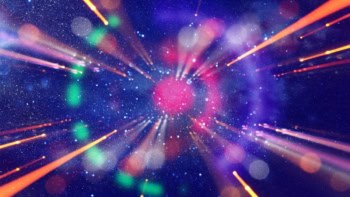From the smallest of interactions to the most powerful galactic phenomena, scientists are searching far and wide for the signatures of dark matter. In the second of a three-part series, Keith Cooper discovers that with so little known about this mysterious part of the universe, scientists find their theories of dark matter pitted against each other
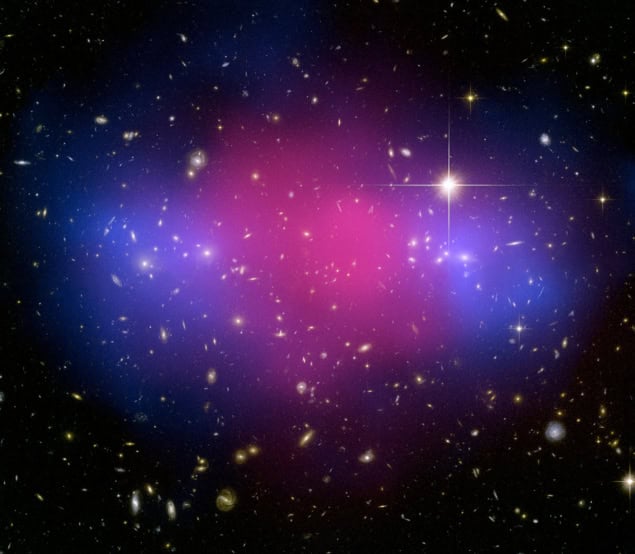
A former South Dakota gold mine is the last place you might think to look to solve one of the universe’s biggest mysteries. Yet what lies buried in the Sanford Underground Research Facility, 1.47 km beneath the surface, could be our best chance of detecting the ghost of the galaxy: dark matter.
Deep within those old mine tunnels, accessible only by a shaft from the surface, is seven tonnes of liquid xenon, sitting perfectly still (figure 1).
This is the LUX-ZEPELIN (LZ) experiment. It’s looking for the tiny signatures that dark matter is predicted to leave in its wake as it passes through the Earth. To have any chance of success, LZ needs to be one of the most sensitive experiments on the planet.
“The centre of LZ, in terms of things happening, is the quietest place on Earth,” says Chamkaur Ghag, a physicist from University College London in the UK, and spokesperson for the LZ collaboration. “It is the environment in which to look for the rarest of interactions.”
For more than 50 years astronomers have puzzled over the nature of the extra gravitation first observed in galaxies by Vera Rubin, assisted by Kent Ford, who noticed stars orbiting galaxies under the influence of more gravity than could be accounted for by visible matter. (In the 1930s Fritz Zwicky had noticed a similar phenomenon in the movement of galaxies in the Coma Cluster.)
Most (though not all – see part one of this series “Cosmic combat: delving into the battle between dark matter and modified gravity“) scientists believe this extra mass to be dark matter. “We see these unusual gravitational effects, and the simplest explanation for that, and one that seems self-consistent so far, is that it’s dark matter,” says Richard Massey, an astrophysicist from Durham University in the UK.
The standard model of cosmology tells us that about 27% of all the matter and energy in the universe is dark matter, but no-one knows what it actually is. One possibility is a hypothetical breed of particle called a weakly interacting massive particle (WIMP), and it is these particles that LZ is hoping to find. WIMPs are massive enough to produce a substantial gravitational field, but they otherwise only gently interact with normal matter via the weak force.
With more questions than answers, the search for dark matter is heading for a showdown
“The easiest explanation to solve dark matter would be a fundamental particle that interacts like a WIMP,” says Ghag. Should LZ fail in its mission, however, there are other competing hypotheses. One in particular that is lurking in the wings is a lightweight competitor called the axion.
Experiments are under way to pin down this vast, elusive portion of the cosmos. With more questions than answers, the search for dark matter is heading for a showdown.
Going deep underground
According to theory, as our solar system cruises through space we’re moving through a thin fog of dark matter. Most of the dark-matter particles, being weakly interacting, would pass through Earth, but now and then a WIMP might interact with a regular atom.
This is what LZ is hoping to detect, and the seven tonnes of liquid xenon are designed to be a perfect WIMP trap. The challenge the experiment faces is that even if a WIMP were to interact with a xenon atom, it has to be differentiated from the other particles and radiation, such as gamma rays, that could enter the liquid.
1 Buried treasure

The seven-tonne tank of liquid xenon that comprises the LZ detector. The experiment is located almost a mile beneath the Earth to reduce background effects, which astronomers hope will enable them to identify weakly interacting massive particles (WIMPs).
Both a gamma ray and a WIMP can create a cloud of ionized free electrons inside the detector, and in both cases, when the ionized electrons recombine with the xenon atoms, they emit flashes of light. But both mechanisms are slightly different, and LZ is designed to detect the unique signature of a WIMP interaction.
When a gamma ray enters the detector it can interact with an electron in the xenon, which flies off and causes a chain of ionizations by interacting with other neighbouring electrons. The heavy WIMP, however, collides with the xenon nucleus, sending it spinning through the liquid, bumping into other nuclei, and indirectly ionizing a few atoms along the way.
To differentiate these two events, an electric field of a few tens of kilovolts is cast across the xenon tank, drawing some of the ionized electrons toward the top of the tank before they can recombine. When these electrons reach the top, they enter a thin layer of gas and produce another, second, burst of light.
When a gamma ray enters the tank, the second flash is brighter than the first – the recoil electron flies off like a bullet, and most of the electrons it liberates are pulled up by the detector before they recombine.
A nucleus is much heavier than an electron, so when a WIMP interacts with the xenon, the path of the recoil is shorter. The cloud of electrons generated by the interaction is therefore localized to a smaller area and more of the electrons find a “partner” ion to recombine with before the electric field can pull them away. This means that for a WIMP, the first flash is brighter than the second.
In practice, there is a range of brightnesses depending upon the energies of the particles, but statistically an excess of brighter first flashes above a certain background level would be a strong signature of WIMPs.
“Looking for dark matter experimentally is about understanding your backgrounds perfectly,” explains Ghag. “Any excess or hint of a signal above our expected background model – that’s what we’re going to use to ascribe statistical significance.”
LZ is now up and running, as of late 2021, and has completed about 5% of its search. Before it could begin its hunt, the project had to endure a five-year process to screen every component of the detector, to make sure that the background effects of every nut, bolt and washer have been accounted for.
WIMPs in crisis?
How many, if any, WIMPs are detected will inform physicists about the interaction cross-section of the dark-matter particle – meaning how likely it is to interact with normal matter it comes into proximity with.
The timing couldn’t be more crucial. Some of the more popular WIMP candidates are predicted by a theory called “supersymmetry”, which posits that every particle in the Standard Model has a more massive “superpartner” with a different quantum spin. Some of these superpartners were candidates for WIMPs but the Large Hadron Collider (LHC) has failed to detect them, throwing the field – and the hypothetical WIMPs associated with them – into crisis.
Francesca Chadha-Day, a physicist who works at Durham University and who studies dark-matter candidates based on astrophysical observations, thinks time may be up for supersymmetry. “The standard supersymmetric paradigm hasn’t materialized, and I think it might be in trouble,” she says.
Ruling out WIMPs now would be like building the LHC but stopping before turning it on
Chamkaur Ghag
She does, however, stress that supersymmetry is “only one source of WIMPs”. Supersymmetry was proposed to explain certain problems in physics, such as why gravity is more feeble than the weak force. Even if supersymmetry is a dead end, there are alternative theories to solve these problems that also predict the existence of particles that could be WIMPs.
“It’s way too early to give up on WIMPs,” adds Ghag. LZ needs to run for at least 1000 days to reach its full sensitivity and he says that ruling out WIMPs now would be “like building the LHC but stopping before turning it on”.
The axion universe
With question marks nevertheless hanging over WIMPs, an alternative type of dark-matter particle has been making waves.
Dubbed axions, Chadha-Day describes them as “dark matter for free”, because they were developed to solve an entirely different problem.
“There’s this big mystery in particle physics that we call the Strong CP Problem,” says Chadha-Day. C refers to charge and P, parity. The CP problem describes how, if you switch a particle for its oppositely charged antiparticle and swap it for a spatial mirror image, the laws of physics would still function the same for it.

Cosmic combat: delving into the battle between dark matter and modified gravity
The Standard Model predicts that the strong force, which glues quarks together inside protons and neutrons, should actually violate CP symmetry. Yet in practice, it plays ball with the conservation of charge and parity. Something is intervening and interacting with the strong force to maintain symmetry. This something is proposed to be the axion.
“The axion is by far the most popular way of solving the Strong CP Problem because it is the simplest,” says Chadha-Day. “And then when you look at the properties of the axion you also find that it can act as dark matter.”
Supersymmetry’s difficulties have seen a recent boom in support for axions as dark matter
These properties include rarely interacting with other particles and sometimes being non-relativistic, meaning that some axions would move slowly enough to clump into haloes around galaxies and galaxy clusters, which would account for their additional mass. Like WIMPs, however, axions have yet to be detected.
Supersymmetry’s difficulties have seen a recent boom in support for axions as dark matter. “There are strong motivations for axions,” says Ghag, “Because they could exist even if they are not dark matter.”
Lensing patterns
Axions are predicted to be lighter than WIMPs and to interact with matter via the electromagnetic force (and gravity) rather than the weak force. Experiments to directly detect axions use magnetic fields, because in their presence an axion can transform into a photon. However, because axions might exist even if they aren’t dark matter, to test them against WIMPs, physicists have to take a different approach.
The extra mass from dark matter around galaxies and galaxy clusters can bend the path of light coming from more distant objects, magnifying them and warping their appearance, sometimes even producing multiple images (figure 2). The shape and degree of this effect, called “gravitational lensing”, is impacted by the distribution of dark matter in the lensing galaxies. WIMPs and axions are predicted to distribute themselves slightly differently, so gravitational lensing can put the competing theories to the test.
2 Seeing quadruple
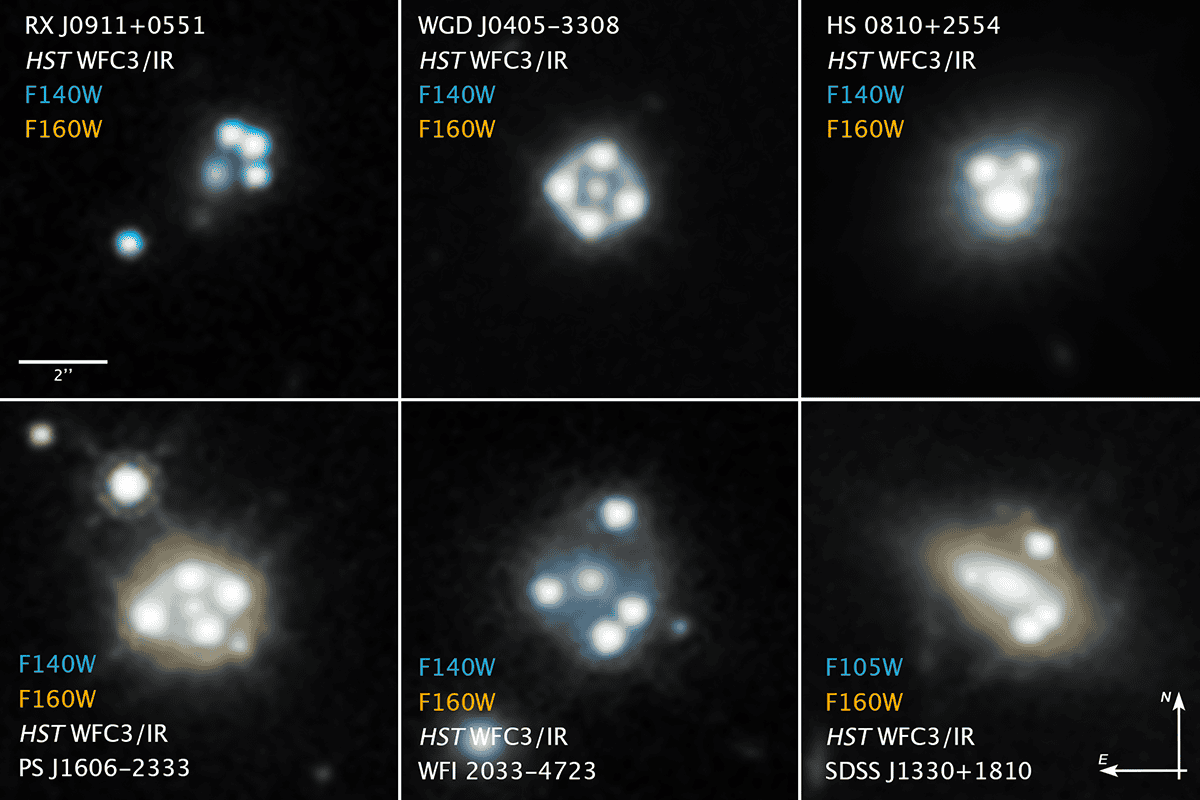
Galaxies and galaxy clusters can bend the light coming from bright background objects such as quasars, creating magnified images. If the lensing effect is strong, as in these images, we may even observe multiple images of a single quasar. The top right image shows quasar HS 0810+2554 (see figure 4).
If dark matter is WIMPs, then they will form a dense clump at the centre of a galaxy, smoothly dispersing with increasing distance. Axions, however, operate differently. “Because axions are so light, quantum effects become more important,” says Chadha-Day.
These effects should show up on large scales – the axion halo around a galaxy is predicted to exhibit long-range quantum interference patterns, with the density fluctuating in peaks and troughs thousands of light-years across.
Gravitational lensing could potentially be used to reveal these patterns, using something called the “critical curve”. Think of a gravitational lens as a series of lines where space has been warped by matter, like on a map where the contour lines indicate height. The critical curve is where the contours bunch up the most (figure 3).
3 Cosmic cartography
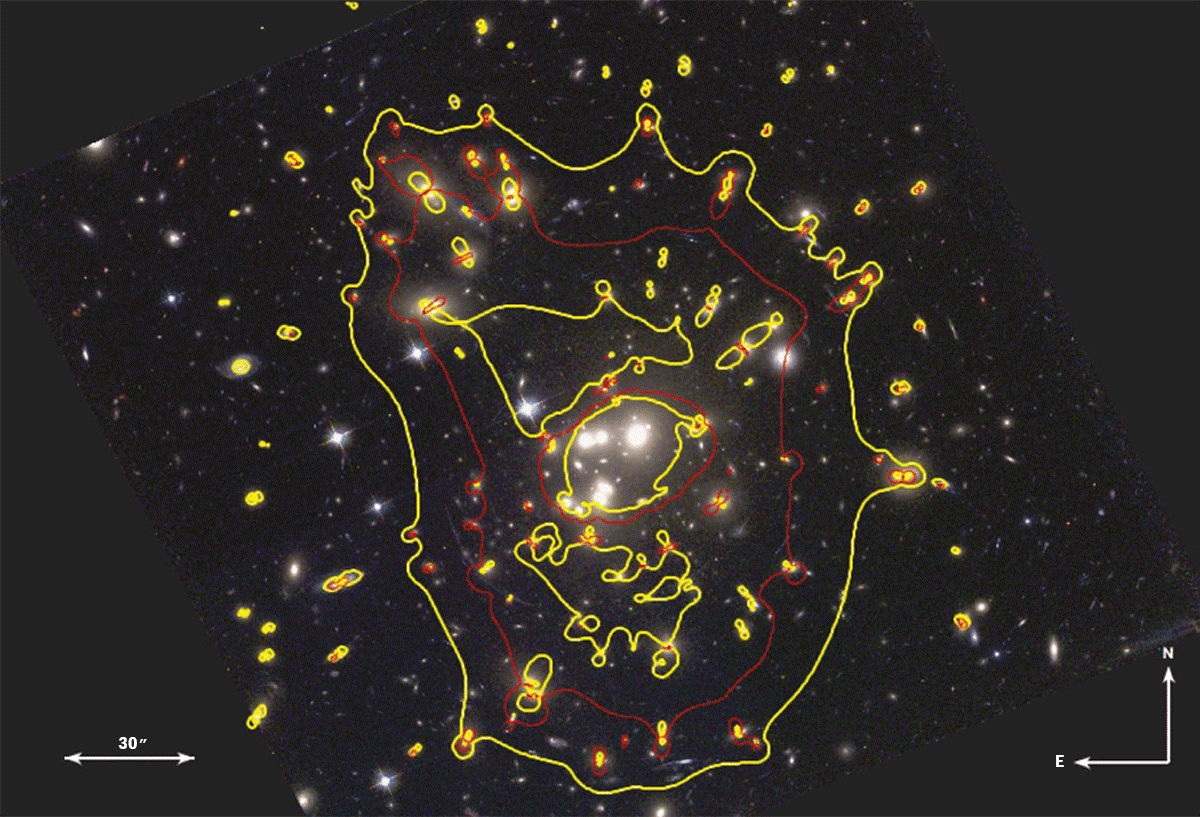
Gravitational lensing around the Abell 1689 galaxy cluster. Red lines indicate the critical curve where magnification is infinite and yellow contours indicate the regions of the sky where objects are magnified by more than a factor of 10.
Critical curves “are lines of sight in the universe where you get enormous magnification in gravitational lensing, and they have different patterns depending on whether dark matter is WIMPs or axions”, says Massey. With axions, the quantum interference pattern can render the critical curve wavy.
In 2023 a team led by Alfred Amruth of the University of Hong Kong found some evidence of wavy effects in the critical curve. They studied the quasar HS 0810+2554 – the incredibly luminous core of a distant galaxy that is being gravitationally lensed (we can see four images of it from Earth) by a foreground object. They found that the lensing pattern could be better explained by axions than WIMPs (figure 4), though because they only studied one system, this is far from a slam dunk for axions.
Dark-matter interactions
Massey prefers not to tie himself to any one particular model of dark matter, instead opting to take a phenomenological approach. “I look to test whether dark-matter particles can interact with other dark-matter particles,” he says. Measuring how much dark matter interacts with itself (another kind of cross section) can be used to narrow down its properties.
4 Making waves
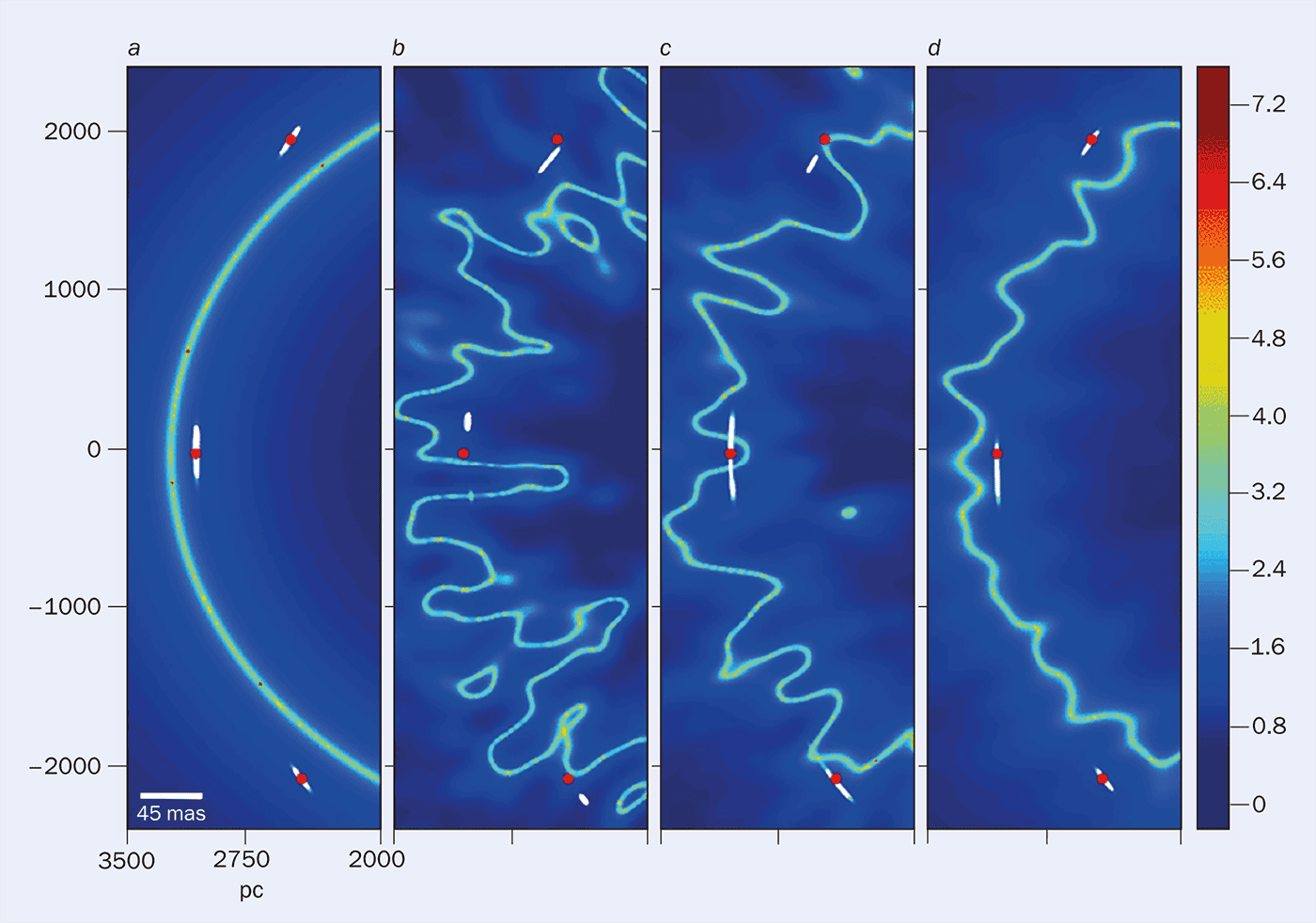
The shape of a gravitational lens would change depending on whether dark matter is WIMPs or axions. Alfred Amruth and colleagues developed a model of the gravitational lensing of quasar HS 0810+2554 (see figure 2). Light from the quasar is bent around a foreground galaxy, and the shape of the gravitational lensing depends on the properties of the dark matter in the galaxy. The researchers tested models of both WIMP-like and axion-like dark matter.
The colours indicate the amount of magnification, with the light blue lines representing the critical curves of high magnification. Part a shows a model of WIMP-like dark matter, whereas b, c and d show different models of axionic dark matter. Whereas the WIMP-like critical curve is smooth, the interference between the wavelike axion particles makes the critical curve wavy.
The best natural laboratories in which to study dark matter interacting with itself are galaxy cluster collisions, where vast quantities of matter and, theoretically, dark matter collide. If dark-matter halos are interacting with each other in cluster collisions, then they will slow down, but how do you measure this when the objects in question are invisible?
“This is where the bits of ordinary matter are actually useful,” says Massey. Cluster collisions contain both galaxies and clouds of intra-cluster hydrogen. Using gravitational lensing, scientists can work out where the dark matter is in relation to these other cosmic objects, which can be used to work out how much it is interacting.
The galaxies in clusters are so widely spaced that they sail past each other during the collision. By contrast, intra-cluster hydrogen gas clouds are so vast that they can’t avoid each other, and so they don’t move very far. If the dark matter doesn’t interact with itself, it should be found out with the galaxies. If the interaction is strong, however, it will be located with the hydrogen clouds. If it interacts just a bit, then the dark matter will be somewhere in-between. Its location can therefore be used to estimate the interaction cross-section, and this value can be handed to theorists to test which dark-matter model best fits the bill.
High-altitude astronomy
The problem is that cluster collisions can take a hundred million years to run their course. What’s needed is to see galaxy cluster collisions at all stages, with different velocities, from different angles.
Enter SuperBIT – the Super Balloon-borne Imaging Telescope, on which Massey is the UK principal investigator. Reaching 40 km into the atmosphere while swinging beneath a super-pressure balloon provided by NASA, SuperBIT was a half-metre aperture telescope designed to map dark matter in as many galaxy-cluster collisions as possible to piece together the stages of such a collision.
SuperBIT flew five times, embarking on its first test flight in September 2015 (figure 5). “We would bring it back down, tinker with it, improve it and send it back up again, and by the time of the final flight it was working really well,” says Massey.
5 Far from home

The SuperBIT telescope took gravitational lensing measurements of cluster collisions to narrow down the properties of dark matter. This photo of the Earth was taken from SuperBIT during one of its five flights.
That final flight took place during April and May 2023, launching from New Zealand and journeying around the Earth five and a half times. The telescope parachuted to its landing site in Argentina, but while it touched down well enough, the release mechanism had frozen in the stratosphere and the parachute did not detach. Instead, the wind caught it and dragged SuperBIT across the landscape.
“It went from being aligned to within microns to being aligned within kilometres! The whole thing was just a big pile of mirrors and metal, gyroscopes and hard drives strewn across Argentina, and it was heart-breaking,” says Massey, who laughs about it now. Fortunately, the telescope had worked brilliantly and all the data had been downloaded to a remote drive before catastrophe struck.
As long as a detection remains elusive, the identity of dark matter will continue to be a sore point for astronomers and physicists
The SuperBIT team is working through that data now. If there is any evidence that dark-matter particles have collided, the resulting estimate of the interaction cross-section will point to specific theoretical models and rule out others.
Astronomical observations can guide us, but only a positive detection of a dark-matter particle in an experiment such as LZ will settle the matter. As long as a detection remains elusive, the identity of dark matter will continue to be a sore point for astronomers and physicists. It also keeps the door ajar for alternative theories, and proponents of modified Newtonian dynamics (MOND) are already trying to exploit those cracks, as we shall see in the third and final part of this series.
- In the first instalment of this three-part series, Keith Cooper explored the struggles and successes of modified gravity in explaining phenomena at varying galactic scales

